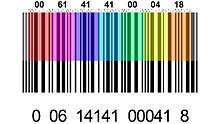Interleaved 2 of 5
Interleaved 2 of 5 (ITF) is a continuous two-width barcode symbology encoding digits. It is used commercially on 135 film, for ITF-14 barcodes, and on cartons of some products, while the products inside are labeled with UPC or EAN.



ITF encodes pairs of digits; the first digit is encoded in the five bars (or black lines), while the second digit is encoded in the five spaces (or white lines) interleaved with them. Two out of every five bars or spaces are wide (hence exactly 2 of 5). The digits are encoded to symbols as follows:
| Digit | Bar or space width | Mnemonic (using weights) | ||||
|---|---|---|---|---|---|---|
| 0 | n | n | W | W | n | 4+7=11, replaced by 0 |
| 1 | W | n | n | n | W | 1+0=1 |
| 2 | n | W | n | n | W | 2+0=2 |
| 3 | W | W | n | n | n | 1+2=3 |
| 4 | n | n | W | n | W | 4+0=4 |
| 5 | W | n | W | n | n | 1+4=5 |
| 6 | n | W | W | n | n | 2+4=6 |
| 7 | n | n | n | W | W | 7+0=7 |
| 8 | W | n | n | W | n | 1+7=8 |
| 9 | n | W | n | W | n | 2+7=9 |
| Weight | 1 | 2 | 4 | 7 | 0 | |
Where "n" is a narrow line (bar or space) and "W" a wide line (2.0 to 3.0 times the width of a narrow line). The wide lines form a two-out-of-five code with consecutive values of 1, 2, 4, 7, and 0, where the code 0 has a value of 11. This is similar to the POSTNET bar code.
Before the actual pairs there is a start code consisting of nnnn (narrow bar-narrow space- narrow bar-narrow space), and after all symbols there is the stop code consisting of Wnn (Wide bar-narrow space-narrow bar).
Because digits are encoded by pairs, only an even number of digits can be encoded. Typically an odd number of digits is encoded by adding a "0" as first digit, but sometimes an odd number of digits is encoded by using five narrow spaces in the last digit.[1]
A checksum can be added as last digit, which is calculated in the same way as UPC checksums.
There are specific constraints on the height and width of the bars and the width of the "quiet areas", the blank areas before the start and after the stop symbol.[2][3]
On 135 film (35 mm) canisters it is used to identify the manufacturer, the film type, number of exposures and proprietary information in 6 digits. The barcode is located between the electrically read silver and black DX Camera Auto-Sensing Code and the film can exit lip. It is optically scanned by many film-processing machines when the cartridge is inserted for developing.[4]
Identcode and Leitcode are variants of interleaved 2 of 5 with check digits used by Deutsche Post.
See also
References
- Note however that the latter strategy causes the last special pair of symbols to be narrower than other pairs.
- Adams, Russ (20 June 2013). "All About Interleaved 2 of 5 Barcode". BarCode 1. Retrieved 5 January 2017.
- Johnson, Nick (18 August 2005). "Interleaved 2 of 5". Everything you Never Wanted to Know About Barcodes. Archived from the original on July 16, 2007. Retrieved August 21, 2007.
- US 5761558, Patton, David Lynn; Lawrence Joseph Travis & Douglas Andrew McPherson, "Expanded film cartidge bar code", published 5 June 1995, issued 2 June 1998, assigned to Eastman Kodak Company
External links

